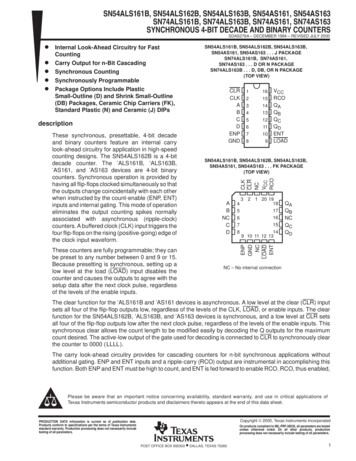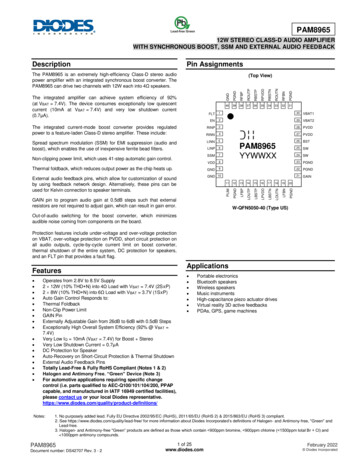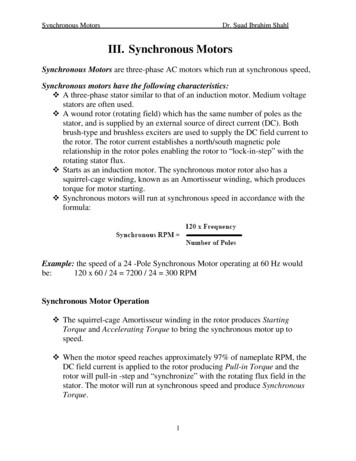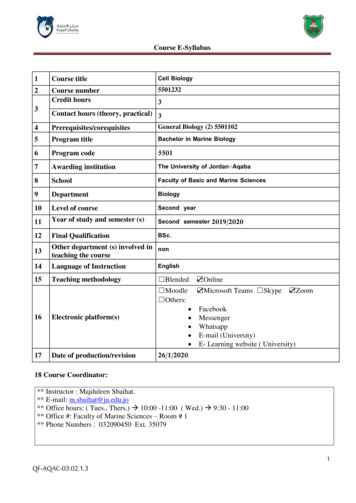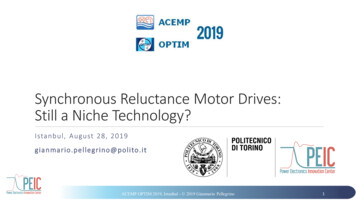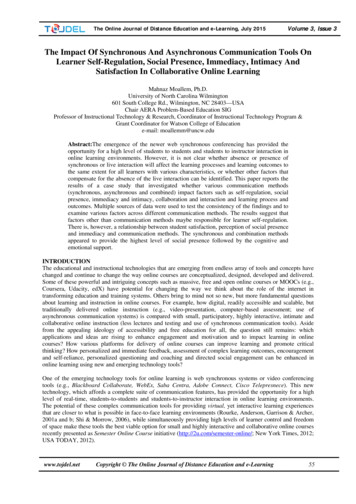
Transcription
The Online Journal of Distance Education and e-Learning, July 2015Volume 3, Issue 3The Impact Of Synchronous And Asynchronous Communication Tools OnLearner Self-Regulation, Social Presence, Immediacy, Intimacy AndSatisfaction In Collaborative Online LearningMahnaz Moallem, Ph.D.University of North Carolina Wilmington601 South College Rd., Wilmington, NC 28403—USAChair AERA Problem-Based Education SIGProfessor of Instructional Technology & Research, Coordinator of Instructional Technology Program &Grant Coordinator for Watson College of Educatione-mail: moallemm@uncw.eduAbstract:The emergence of the newer web synchronous conferencing has provided theopportunity for a high level of students to students and students to instructor interaction inonline learning environments. However, it is not clear whether absence or presence ofsynchronous or live interaction will affect the learning processes and learning outcomes tothe same extent for all learners with various characteristics, or whether other factors thatcompensate for the absence of the live interaction can be identified. This paper reports theresults of a case study that investigated whether various communication methods(synchronous, asynchronous and combined) impact factors such as self-regulation, socialpresence, immediacy and intimacy, collaboration and interaction and learning process andoutcomes. Multiple sources of data were used to test the consistency of the findings and toexamine various factors across different communication methods. The results suggest thatfactors other than communication methods maybe responsible for learner self-regulation.There is, however, a relationship between student satisfaction, perception of social presenceand immediacy and communication methods. The synchronous and combination methodsappeared to provide the highest level of social presence followed by the cognitive andemotional support.INTRODUCTIONThe educational and instructional technologies that are emerging from endless array of tools and concepts havechanged and continue to change the way online courses are conceptualized, designed, developed and delivered.Some of these powerful and intriguing concepts such as massive, free and open online courses or MOOCs (e.g.,Coursera, Udacity, edX) have potential for changing the way we think about the role of the internet intransforming education and training systems. Others bring to mind not so new, but more fundamental questionsabout learning and instruction in online courses. For example, how digital, readily accessible and scalable, buttraditionally delivered online instruction (e.g., video-presentation, computer-based assessment; use ofasynchronous communication systems) is compared with small, participatory, highly interactive, intimate andcollaborative online instruction (less lectures and testing and use of synchronous communication tools). Asidefrom the appealing ideology of accessibility and free education for all, the question still remains: whichapplications and ideas are rising to enhance engagement and motivation and to impact learning in onlinecourses? How various platforms for delivery of online courses can improve learning and promote criticalthinking? How personalized and immediate feedback, assessment of complex learning outcomes, encouragementand self-reliance, personalized questioning and coaching and directed social engagement can be enhanced inonline learning using new and emerging technology tools?One of the emerging technology tools for online learning is web synchronous systems or video conferencingtools (e.g., Blackboard Collaborate, WebEx, Saba Centra, Adobe Connect, Cisco Telepresnece). This newtechnology, which affords a complete suite of communication features, has provided the opportunity for a highlevel of real-time, students-to-students and students-to-instructor interaction in online learning environments.The potential of these complex communication tools for providing virtual, yet interactive learning experiencesthat are closer to what is possible in face-to-face learning environments (Rourke, Anderson, Garrison & Archer,2001a and b; Shi & Morrow, 2006), while simultaneously providing high levels of learner control and freedomof space make these tools the best viable option for small and highly interactive and collaborative online coursesrecently presented as Semester Online Course initiative (http://2u.com/semester-online/; New York Times, 2012;USA TODAY, 2012).www.tojdel.netCopyright The Online Journal of Distance Education and e-Learning55
The Online Journal of Distance Education and e-Learning, July 2015Volume 3, Issue 3Synchronous web-conferencing is one of the two communication methods (synchronous and asynchronous) usedfor delivery of course content and for course-related communication and interaction. While its use is still limited(Sloan, 2013), synchronous method for delivery of online courses brings teacher and students togethersimultaneously in virtual spaces. Asynchronous method, on the other hand, delivers instruction without anyspecific timetable using communication tools such as e-mail, discussion boards and web 2.0 tools. Althoughlimited due to the relatively new synchronous web-conferencing tools, studies suggest that absence or presenceof synchronous or live interaction affects student perception, motivation, interaction and sense of contribution(e.g., Barbour, McLaren & Zhang, 2012; Chen, Pedersen & Murphy, 2011; Falloon, 2011; Hampel & Stickler,2012; Han & Johnson, 2012; McBrien, Jones & Cheng, 2009; Schullo, Hilbelink, Venable, & Barron, 2007;Teng, Chen, Kinshuk & Leo, 2012). However, much of this research has focused on the quality of interaction ordialogue and learner perception, rather than learning process and learning outcomes. In addition, few studiesattempted to isolate learning strategies used in online courses from delivery platforms, making it difficult todescribe if the two types of communication methods (synchronous and asynchronous) for delivery of onlinecourses result in different levels and processes of learning, motivation and satisfaction.The purpose of the present study was to compare three communication methods (synchronous web-conferencing;asynchronous, and a combined method of synchronous and asynchronous) while keeping learning strategiesconsistent across each method to find out how they influence learner motivation and self-regulation, socialpresence, satisfaction and learning process and outcomes, in small, interactive and collaborative online courses.The study specifically answers the following questions: How do various communication methods (synchronous, asynchronous and combined) impact factorssuch as self-regulation, social presence, immediacy and intimacy and satisfaction in online learning? How do various communication methods (synchronous, asynchronous and combined) impact studentcollaboration and interaction as well as learning process and learning outcomes?REVIEW OF THE LITERATUREThe review of the literature on the effect of the quality and level of interactions offered in variouscommunications modes (i.e. synchronous and asynchronous) on student learning, satisfaction and motivation inonline learning environments points to several influencing factors: possibility of affective and interpersonalinteractions; social and cognitive presence; immediacy of feedback; motivation and self-regulation; mediarichness; and collaborative opportunities for learners. These factors are explored in the following sections andare used to construct a framework to guide the present study.Research on online learning continues to support Moore’s contention (1989) of the importance of dialogue orinteraction between the teacher and students and among students and between students and learning content foradvancing the learning process and for internalizing learning (e.g., Cavanaugh, 2005; Friend & Johnson, 2005;Offir, Lev & Bezale, 2008; Palloff & Pratt, 1999; Shale & Garrison, 1990; Zucker & Kozma, 2003). These andother studies further elaborate that higher level of interactivity (human interaction) captures learner’s attentionand increases user’s engagement with the task environment (e.g., Alessi & Trollip, 2001; Heinich et al., 1989). Itis argued that high level of interactivity results in deeper processing of the information, resulting in mastery ofthe information (Brown, Collins, & Duguid, 1989; Merrill, 1975), aiding the individual in forming a personalmental model of the task (Wild, 1996). According to Moore, distance learning environments, separation betweenthe teacher and students can “lead to communication gaps, a psychological space of potential misunderstandingsbetween the behaviors of instructors and those of the learners” (Moore & Kearsley, 1996, p. 200). Thus, giventhe literature, one can theorize that when the task is complex and involves the construction of new knowledge,problem solving and shared meaning, the communication utilization of a richer synchronous medium becomesmore important (Dennis & Valacich, 1999).Other studies point that increased interaction results in increased student motivation and satisfaction (e.g., Chiu,Hsu, Sun, Lin & Sun, 2005; Garrison, Anderson, & Archer, 2001; Irani, 1998; Lee, Tseng, Liu & Liu, 2007;Schullo, Hilbelink, Venable, & Barron, 2007; Wang, 2003; Zhang & Fulford, 1994; Zirkin & Sumler, 1995).Furthermore, student’s personal perceptions of social presence (“degree of salience of other person in themediated interaction” (Short, et. al., 1979, p. 65)) combined with the capabilities of the medium to presentpersonal and emotional connections (Garrison, 2003) influence interaction, which, in turn, sustain or enhancelearner motivation and satisfaction. Included in the construct of social presence are concepts of immediacy(“physical and verbal behaviors that reduce the psychological and physical distance between individuals”(Baker, 2010, p. 4)) and intimacy (a function of eye contact, physical proximity, topic of conversation, etc.(Argyle & Dean, 1965)). Researchers suggest that instructor’s immediacy is positively related to studentwww.tojdel.netCopyright The Online Journal of Distance Education and e-Learning56
The Online Journal of Distance Education and e-Learning, July 2015Volume 3, Issue 3cognition, affective learning and motivation (Arbaugh, 2001; Baker, 2004, 2010; McAlister, 2001), and thatsynchronous online instruction provides more immediacy than asynchronous communication alone (Haefner,2000; Pelowski, Frissell, Cabral, & Yu, 2005). In addition, a number of studies show that synchronouscommunication helps break down a sense of isolation, assists in the formation of learning communities andpromotes interaction and participation (e.g., Dal Bello, Knowlton, & Chafin, 2007; Fox, Morris, & Rumsey,2007; Gosmire, Morrison, & van Osdel, 2009; Hrastinski, 2008; Schullo, Hilbelink, Venable, & Barron, 2007;Sharma, 2006; Yang & Liu, 2007).There is much empirical evidence that motivation and its related theory of self-regulated learning are of greatimportance for academic achievement (Zimmerman 1990; Zimmerman & Schunk 2001). Self-regulated learningis defined as “an active, constructive process whereby learners set goals for their own learning and then attemptto monitor, regulate, and control their cognition, motivation, and behavior, guided and constrained by their goalsand the contextual features in the environment” (Perry & Smart, 2002, p. 741). In sum, self-regulated learners aremotivated, independent, and metacognitively active participants in their own learning (Zimmerman, 1990).Researchers studied online learning argue that in online learning environments, learners have to assume greatercontrol of monitoring and managing the cognitive and contextual aspects of their own learning. Thus, thelearner's self-motivation increases as a result of self-regulatory attributes and self-regulatory processes in onlinelearning (Eom, Wen & Ashill, 2006). This research highlights the impact of self-regulation on learningachievement in online learning as well as influence of online learning on learners’ motivation or self-regulatorybehaviors.Finally, research points to the relationships between media attributes and task complexity in technologymediated learning. The impact of different technology characteristics to present information and forcommunication may depend on task complexity (Tan & Benbasat, 1990; Tractinsky & Meyer, 1999). In theirMedia Richness Theory, Daft and Wiginton (1979) refer “richness” to the medium’s capacity for immediatefeedback, the number of cues and channels utilizing personalization and language variety. Communications thattake a longer time to convey understanding, therefore, are less rich. In this context, the richness ofcommunication features provided by the synchronous and asynchronous tools influence learner’s ability toengage in solving problems and completing complex learning tasks. Researchers contend that performance of amore complex task requires the learner to generate a more elaborate mental model (White & Frederiksen, 1990).Skehan and Foster (2001) further explain “task difficulty has to do with the amount of attention the task demandsfrom the participants. Difficult tasks, therefore, require more attention than easy tasks (p. 196).” Thus, it can beconcluded that engaging learners in complex learning tasks (e.g., problem solving and critical thinking) in onlinelearning environments requires utilization of rich media that provide immediate feedback, multiple cues,message tailoring, emotions and contextual cues.The above-mentioned factors and findings derived from the literature were used to conceptualize a frameworkthat could describe the variables under investigation, their impact on the design and implementation of the studyand to provide the researchers the opportunity to gather general constructs into intellectual “bins” (Miles &Huberman, 1994, p. 18) (see Figure 1). As shown in Figure 1, it is conceptualized that an online course can bedelivered using various communication methods or delivery systems. While in all modes of communicationinteraction could be between student-content, student-student and student-instructor (Moore, 1989), the richnessand quality of this interaction and its impact on learning and motivation may differ depending on the influence ofthe factors identified by the literature (see Figure 1).www.tojdel.netCopyright The Online Journal of Distance Education and e-Learning57
The Online Journal of Distance Education and e-Learning, July 2015Volume 3, Issue 3Figure 1. The conceptual framework for the studyRESEARCH CONTEXT AND PROCEDUREA small three hour graduate core course (maximum of 15 students) in the Instructional Technology program at amidsize southeastern public university was used to conduct the study. The course is only offered in springsemester in each academic year and is a required course for all students enrolled in the program. Students whoenroll in this course have been in the program for at least one semester prior to this course (often fall of the sameacademic year) and have taken at least three credit hours course in the program. The study was conducted inspring of 2011 and was repeated in spring of 2012 with a new group of students. One of the researchers was theinstructor of the record for the course. Fourteen students enrolled in spring 2011 course and 13 students enrolledin spring of 2012. At the beginning of each semester and before the classes started, students were invited toparticipate in the research by signing a standard informed consent protocol. All enrolled students (both in spring2011 and 2012) agreed to participate in the study. The study had approval from the university IRB committee.Three modules (two weeks of instruction for each method of delivery) were used to conduct the study. Module 1(week 2 and 3) was delivered using asynchronous only method of delivery. Module 2 (week 4 and 5) wasdelivered using synchronous only method and Module 3 (week 5 and 6) was delivered using a combinationmethod. The first meeting for the course was synchronous and virtual and used as an orientation to explain thecourse, its syllabus, assignments and problem-based orientation and to form collaborative teams and to completepre-intervention surveys and questionnaires. In order to ensure consistency in learning strategies and taskdifficulty for all three modules and across two courses, problem-based learning (PBL) or Constructivist LearningEnvironments model (Jonassen, 2008) was used as the instructional design framework for the course. Therefore,the focus of learning activities for each module was to solve ill-structured real-world problems to apply targetedknowledge and skills for each module while working in collaborative teams. In addition, the three types ofinteraction (student-content, student-student and student-instructor) were offered for each module regardless ofthe communication method. The following provides detail procedure for each module.Module 01 (Week 1 and 2) Asynchronous: Students were assigned readings (e.g., instructors’ lecture andmultimedia materials) a week earlier. Teams of three or four members were formed to collaborate in completingproblem-solving activities for each week. A small group discussion area was created for each team as theyworked on their team assignment. A large group discussion forum was also created to provide opportunity forinteraction among all students and with the instructor. Students were instructed not to meet synchronously andjust use asynchronous tools to communicate and to complete their team assignments even if they might havebeen in close proximity with each other. At the end of each week, the teams submitted and published theirassignment to other groups to review and comment. The instructor also provided written feedback and commentson students’ team products and collaboration process in the assignment area.Module 02 (Week 3 and 4) Synchronous: Students were assigned readings (e.g., instructors’ lecture andmultimedia materials) a week before live/synchronous meeting. During live/synchronous class meeting, studentsparticipated in a large group discussion and/or a demonstration with lecture facilitated by the instructor. Thelarge group discussion proceeded with breaking out the large group into small teams that were formed duringModule 01. Teams were assigned to collaborate in completing module’s problem-solving assignment for thewww.tojdel.netCopyright The Online Journal of Distance Education and e-Learning58
The Online Journal of Distance Education and e-Learning, July 2015Volume 3, Issue 3week during live and synchronous class in their virtual breakout meeting rooms. Students were offered tocontinue team discussion in their team’s designated virtual room to follow up on live or synchronous class andteam discussion. However, students were instructed to only use synchronous meetings for completing weeklyteam activities. At the end of each week’s live meeting, teams presented their assignment to other groups toreview and comment and later submitted it in the assignment area. The instructor also reviewed students’ productand collaborative process and offered feedback during synchronous or live meeting. In addition to oralcomments from both students and the instructors, the instructor provided written feedback on teams’ productsand collaboration process in the team assignment area.Module 03 (Week 5 and 6) Combination: Students were assigned readings (e.g., instructors’ lecture andmultimedia materials) a week earlier. Students were also assigned to work with their previously formed teamsand were instructed to begin discussing and collaborating with their teams on each week’s problem-solvingassignment using a small group discussion in the forum area. A large group discussion forum was also created toprovide opportunity for interaction among all students and with the instructor before live and synchronous classdiscussion. A live and synchronous class discussion and team meetings followed the asynchronous large andsmall group discussion. During the live and synchronous class meeting, students participated in a large groupdiscussion and/or a demonstration with lecture facilitated by the instructor. The large group discussion proceededwith breaking out the large group into small teams (breakout rooms). Teams then presented their assignment forboth peers’ and instructor’s review and comments and later submitted in the assignment area. As with theprevious modules, in addition to oral comments, the instructor also provided written feedback and comments onstudents’ team product and collaboration process.The course content and course-related communication and interactions were delivered using Blackboard vista(2011) and Blackboard 9 (2012). Horizon Wimba (2011) and WebEx (2012) video conferencing system orSynchronous Communication Systems (SCS) were used for conducting real time classroom discussion andcollaborative group work and presentations. Both SCS systems enabled users to communicate using audio,video, and text and to share files, resources, and presentations using applications such as PowerPoint and Flash.Both platforms also offered functionalities such as application and desktop sharing, which were used forcollaboration on jointly developed documents, or for other instructional purposes. For synchronous deliverymodule, while all students used SCS to communicate with each other and the instructor during live interaction,some students were also physically present in the classroom and had an opportunity to see each other face-toface and distance students through Cisco large video panel in the classroom and video camera on their laptopsand to collaborate with distance students using SCS breakout rooms. All students participated in instruction ofthree units. All assignments, problem-solving activities and discussion topics were kept consistent across thethree modules.PARTICIPANTSFourteen students enrolled in spring 2011 course and 13 students enrolled in spring of 2012. Table 2 summarizesstudent demographic information in each semester. As it is shown in Table 1, students were varied in their ageand work experiences in both semesters. While 71-61% of students in each semester indicated that they had nottaken an online course that used a synchronous communication tool before, about the same percentage (63-69)noted that they had taken online courses that had used asynchronous communication tools. According to thedemographic data, in both semesters students were heterogeneous with regard to age, background andexperiences. Students’ prior work experiences ranged from teaching to working in business and industry,military and private sectors. In spring of 2011, 35% of students had teaching background in k-12, 10% hadadministrative background in public schools and higher education and 55% had business and corporateexperience. In spring of 2012, 69% of students had teaching background while 30.8 % had experience workingin business and industry. In spring 2011, 57% of students were full time and 43% were part time. In spring of2012, 46% were full time and 54% were part time.www.tojdel.netCopyright The Online Journal of Distance Education and e-Learning59
Volume 3, Issue 3The Online Journal of Distance Education and e-Learning, July 2015Table 1. Student demographic data%%%%Spring 2011Spring 2012(N 14)(N 13)Previously taken an online course thatYesYesNoNoused synchronous communication28.671.438.561.5toolsPreviously taken an online course thatYesNoYesNoprimarily used asynchronous63.335.769.230.8communication (forum; e-mail) toolsNumber of credit hours taken in the3-9 courses2-10 coursesprogram?Age22-30 31 22-3031 505038.561.5GenderMFMF28.671.446.253.8Prior college degrees.BS/B ML BS/BMS/MAAAA85151000Prior years’ work experience2-246-27Questions% (Total)2011 & 2012(N 27)YesNo3367Yes67No332-10 courses22-30 31 42.453.6MF3763BS/B MLAA85152-27During the first class meeting (orientation to the course) students were ask to complete Felder and Soloman’s(1998) Index of Learning Styles Survey (a self-scored survey) and report their results to the instructor. Table 2shows the results. With regard to how students preferred to process information, in 2011 more students werereflective learners (learning by thinking things through; working alone) while in 2012 the majority of studentswere active learners (learning by trying things out; working with others). In both years, more students wereoriented toward learning facts and procedures (sensing) rather than concepts, theories and meanings (intuitive)and were more visual than verbal. In 2011, similar number of students preferred learning sequentially (in smallsteps and in orderly manner) and globally (learning holistically and is larger steps). However, in 2012, morestudents preferred learning d%%(#/13)2011(#/13)201253.8 (7)7.1 (1)38.5 (5)76.9(10)7.7 (1)15.4 (2)Table 2. Students’ learning styles 0112011(#/13)(#/13)20122012Intuitive 23.1 (3) Visual61.5 (8)7.7 (1)61.5 (8)Sensing69.2 (9) Verbal38.5 (5)76.930.8 (4)(10)Balanced 7.7 (1)Balanced 015.4 (2)7.7 11(#/13)201246.2 (6)69.2 (9)53.8 (7)23.1 (3)07.7 (1)METHODOLOGYThe study adopted an interpretive or descriptive case study methodology to explore the questions of the study inits context using variety of data sources (Yin, 2003, 2014). According to Yin (2003), a case study design shouldbe considered when: (a) the focus of the study is to answer “how” and “why” questions; (b) it is difficult tomanipulate the behavior of those involved in the study; (c) it is important to cover contextual conditions becausethey are relevant to the phenomenon under study; or (d) the boundaries are not clear between the phenomenonand context. Thus, even though the results are limited in terms of “generalizability,” a case study methodologywas found to be suited for the study because it allowed the researchers to gain deeper insights into values ofvarious communication methods for delivery of online courses.Multiple sources of data were used to test the consistency of the findings and to examine various factors acrossdifferent communication methods. The following data-gathering strategies were used: (1) questionnaires tomeasure student self-regulation, perception of social presence, immediacy and intimacy and student satisfaction;www.tojdel.netCopyright The Online Journal of Distance Education and e-Learning60
The Online Journal of Distance Education and e-Learning, July 2015Volume 3, Issue 3(2) an inventory to assess student learning styles; (3) archive records of student collaboration during group work;(4) results of assessment (knowledge quizzes and solutions to the problem solving tasks) of students’ learning ofthe content and achievement of the modules’ objectives; (5) instructor’s perception and reflection logs andstudents’ responses to reflective questions at the end of each intervention/module; and (6) archive of studentpostings, chat logs and audio archive of SCS class discussion.Different techniques (quantitative and qualitative) were used to organize and systematically review and analyzevarious types of information. Statistical analyses examined the interrelationship among variables within eachdelivery method first, and then the results were used to make comparisons across the three methods of delivery,looking for differences, similarities and patterns. In addition, comparative analysis was conducted between datacollected in spring 2011 and the replicated study in spring 2012. The primary focus of this comparative analysiswas on the overall pattern of results and the extent to which the observed pattern of variables in 2012 matchedthose of 2011 and if not what differences were observed.RESULTSResearch Question 1. How do various communication methods (synchronous, asynchronous and combined)impact factors such as motivation and self-regulation, social presence, immediacy and intimacy, satisfaction,collaboration and interaction?SELF-REGULATIONStudent self-regulation skills were assessed at the beginning and at the end of each module using MotivatedStrategies for Learning Questionnaire (MSLQ) developed by Pintrich, Smith, Garcia, and McKeachie (1991).However, in order to triangulate the consistency of the results, motivation or student self-regulation skills werealso assessed using observation of students’ behaviors using criteria such as participation in collaborativeactivities and discussion, interaction with the content and responses to a series of reflective questions.The adopted scale for assessing self-regulation consisted of 38 items (scale of 1-7; 1 not true of me; 7 verytrue of me) in six categories: Intrinsic (4 items), Extrinsic (4 items), Task Value (6 items), Control of LearningBeliefs (4 items), Self-efficacy (8 items), and Self-regulation (12 items) with reported reliability ranged from0.52 to 0.93 (Pintrich, et al, 1991). The survey was administered prior to the intervention and then administratedat the end of each method. The Cronbach’s alpha reliability Co-efficient was .74 (2011) .96 (2012) for 38 itemsin six categories. The data collected from both semesters were analyzed using a paired sample t-test. The resultsdid not show any significant difference between students’ self-regulation prior to the course and after eachintervention. Students’ overall average score on four items measured intrinsic motivation was high prior to thecourse (ranging from 6.46 to 5.25) and remained high at the end of each module with slightly better scores forsynchronous and mixed methods (see Appendix A). Students’ overall average score for 4 items measuredextrinsic motivation was lower (5.55 to 3.62) compared to intrinsic motivation (6.43 to 5.55) prior to theintervention, a
synchronous or live interaction will affect the learning processes and learning outcomes to the same extent for all learners with various characteristics, or whether other factors that compensate for the absence of the live interaction can be identified. This paper reports the




